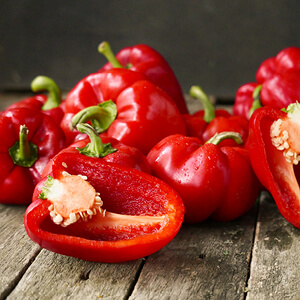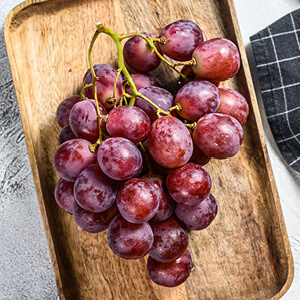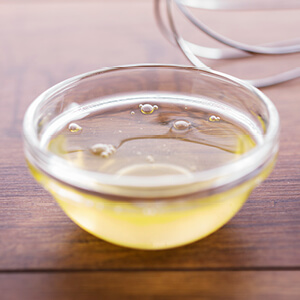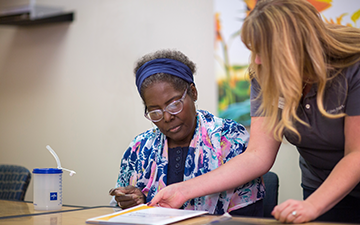Carbohydrates
Carbohydrate, protein and fat are three major nutrients found in foods. Carbohydrates are a major fuel source for your body.
By DaVita dietitian Sara Colman, RD, CSR, CDE
Researchers are discovering more and more links between chronic diseases, inflammation and certain whole foods that may prevent or protect against undesirable fatty acid oxidation, a condition that occurs when the oxygen in your body reacts with fats in your blood and your cells. Oxidation is a normal process for energy production and many chemical reactions in the body, but excessive oxidation of fats and cholesterol creates molecules known as “free radicals” that can damage your proteins, cell membranes and genes. Heart disease, cancer, Alzheimer’s disease, Parkinson’s disease and other chronic and degenerative conditions have been linked to oxidative damage.
Foods that contain antioxidants can help neutralize free radicals and protect the body. Many of the foods that protect against oxidation are included in the kidney diet and make excellent choices for people on dialysis or people with chronic kidney disease (CKD). Eating foods rich in antioxidants as part of your kidney diet and working with a kidney dietitian are important for people with kidney disease because they experience more inflammation and have a higher risk for cardiovascular disease.
Want to learn more about the kidney diet? Download our free kidney-friendly cookbooks filled with kidney diet tips and recipes.

1/2 cup serving red bell pepper = 1 mg sodium, 88 mg potassium, 10 mg phosphorus
Red bell peppers are low in potassium and high in flavor, but that’s not the only reason they’re perfect for the kidney diet. These tasty vegetables are also an excellent source of vitamins C and A, as well as vitamin B6, folic acid and fiber. Red bell peppers are good for you because they contain lycopene, an antioxidant that helps protects against certain cancers.
Eat red bell peppers raw with dip as a snack or appetizer, or mix them into tuna or chicken salad. You can also roast peppers and use them as a topping on sandwiches or lettuce salads, chop them for an omelet, add them to kabobs on the grill or stuff peppers with ground turkey or beef and bake them for a main dish.

1/2 cup serving green cabbage = 6 mg sodium, 60 mg potassium, 9 mg phosphorus
A cruciferous vegetable, cabbage is packed full of phytochemicals, chemical compounds in fruit or vegetables that break up free radicals before they can do damage. Many phytochemicals are also known to help protect cells from damage that could lead to cancer, as well as foster cardiovascular health.
High in vitamin K, vitamin C and fiber, cabbage is also a good source of vitamin B6 and folic acid. Low in potassium and low in cost, it’s an affordable addition to the kidney diet.
Raw cabbage makes a great addition to the dialysis diet as coleslaw or a topping for fish tacos. You can steam, microwave or boil it, add butter or cream cheese plus pepper or caraway seeds and serve it as a side dish. Cabbage Rolls Made with Turkey are a great appetizer, and if you’re feeling fancy, you can stuff a cabbage with ground meat and bake it for a flavorful meal bursting with nutrients.

1/2 cup serving boiled cauliflower = 9 mg sodium, 88 mg potassium, 20 mg phosphorus
Another cruciferous vegetable, cauliflower is high in vitamin C and a good source of folate and fiber. It’s also packed full of indoles, glucosinolates and thiocyanates—compounds that help the liver neutralize toxic substances that could damage cell membranes and DNA.
Serve it raw as crudités with dip, add it to a salad, or steam or boil it and season with spices such as turmeric, curry powder, pepper and herb seasonings. You can also make a nondairy white sauce, pour it over the cauliflower and bake until tender. You can pair cauliflower with pasta or even mash cauliflower as a dialysis diet replacement for mashed potatoes.

1 clove garlic = 1 mg sodium, 12 mg potassium, 4 mg phosphorus
Garlic has antimicrobial properties that help prevent plaque from forming on your teeth, lowers cholesterol and reduces inflammation.
Buy it fresh, bottled, minced or powdered, and add it to meat, vegetable or pasta dishes. You can also roast a head of garlic and spread it on bread. Garlic provides a delicious flavor and garlic powder is a great substitute for garlic salt in the dialysis diet.

1/2 cup serving onion = 3 mg sodium, 116 mg potassium, 3 mg phosphorus
Onion, a member of the Allium family and a basic flavoring in many cooked dishes, contains sulfur compounds which give it its pungent smell. But in addition to making some people cry, onions are also rich in flavonoids, especially quercetin, a powerful antioxidant that may reduce heart disease and protect against many cancers. Onions are low in potassium and a good source of chromium, a mineral that helps with carbohydrate, fat and protein metabolism.
Try using a variety of onions including white, brown, red and others. Eat onions raw on burgers, sandwiches and in salads, or cook them and use as a caramelized topping. If you have an air fryer, you can also try making homemade onion rings. Include onions in recipes such as Italian Beef with Peppers and Onions.

1 medium apple with skin = 0 sodium, 158 mg potassium, 10 mg phosphorus
Apples may help reduce cholesterol, prevent constipation, protect against heart disease and reduce the risk of cancer. High in fiber and anti-inflammatory compounds, an apple a day may really help keep the doctor away—good news for people with kidney disease who already have their share of doctor visits.
This kidney diet winner can be paired with the previous good-for-you food, onions, to make a unique Apple Onion Omelet. Apples are versatile. You can eat them raw, make baked apples, stew apples, make them into apple sauce, or drink them as apple juice or apple cider.

1/2 cup serving cranberry juice cocktail = 3 mg sodium, 22 mg potassium, 3 mg phosphorus
1/4 cup serving cranberry sauce = 35 mg sodium, 17 mg potassium, 6 mg phosphorus
1/2 cup serving dried cranberries = 2 mg sodium, 24 mg potassium and 5 mg phosphorus
These tangy, tasty berries may protect against bladder infections by preventing bacteria from sticking to the bladder wall. In a similar way, cranberries may also protect the stomach from ulcer-causing bacteria and improve overall healthy gut bacteria, promoting GI health. Cranberries have also been shown to help protect against cancer and heart disease.
Cranberry juice and cranberry sauce are the most frequently consumed cranberry products. You can also add dried cranberries to salads or have them as a snack.

1/2 cup serving fresh blueberries = 4 mg sodium, 65 mg potassium, 7 mg phosphorus
Blueberries are high in antioxidant phytonutrients called “anthocyanidins,” which give them their blue color, and they are bursting with natural compounds that help reduce inflammation. Blueberries are a good source of vitamin C, manganese (a compound that keeps your bones healthy) and fiber. They may also help protect the brain from some of the effects of aging. Antioxidants in blueberries and other berries may help slow down bone loss.
Buy blueberries fresh, frozen or dried, and try them in cereal, or topped with whipped topping in a fruit smoothie. You can also drink blueberry juice.

1/2 cup serving raspberries = 0 mg sodium, 93 mg potassium, 7 mg phosphorus
Raspberries contain a phytonutrient called “ellagic acid” which helps neutralize free radicals in the body to prevent cell damage. They also contain flavonoids called “anthocyanins,” antioxidants which give them their red color. An excellent source of manganese, vitamin C, fiber and folate, a B vitamin, raspberries may have properties that inhibit cancer cell growth and tumor formation.
Add raspberries to cereal, puree and sweeten them to make a dessert sauce, or add them to vinaigrette dressing.

1/2 cup serving (5 medium) fresh strawberries = 1 mg sodium, 120 mg potassium, 13 mg phosphorus
Strawberries are rich in two types of phenols: anthocyanins and ellagitannins. Anthocyananins are what give strawberries their red color and are powerful antioxidants that help protect body cell structures and prevent oxidative damage. Strawberries are an excellent source of vitamin C and manganese, and a very good source of fiber. They may provide heart protection, as well as anti-cancer and anti-inflammatory components.
Eat strawberries with cereal, smoothies and salads, or slice and serve them fresh or top them with whipped topping. If you’d like a more elaborate dessert, you can make strawberry pudding or sorbet, or puree and sweeten them to serve as a dessert.

1/2 cup serving fresh sweet cherries = 0 mg sodium, 160 mg potassium, 15 mg phosphorus
Cherries have been shown to reduce inflammation when eaten daily. They are also packed with antioxidants and phytochemicals that help protect the heart.
Eat fresh cherries as a snack or make a cherry sauce to serve with lamb or pork. Cherry juice is another way to consume this tasty food.

1/2 cup serving red grapes = 1 mg sodium, 88 mg potassium, 4 mg phosphorus
Red grapes contain several flavonoids that give them their reddish color. Flavonoids help protect against heart disease by preventing oxidation and reducing the formation of blood clots. Resveratrol, a flavonoid found in grapes, may also stimulate production of nitric oxide which helps relax muscle cells in the blood vessels to increase blood flow. These flavonoids also provide protection against cancer and help prevent inflammation.
Buy grapes with red or purple skin since their anthocyanin content is higher. Freeze them to eat as a snack or to quench thirst for those on a fluid restriction for the dialysis diet. Add grapes to a fruit salad or chicken salad. Try a unique kidney diet recipe for Turkey Kabobs that features grapes. You can also drink them as grape juice.

2 egg whites = 7 grams protein, 110 mg sodium, 108 mg potassium, 10 mg phosphorus
Egg whites are pure protein and provide high-quality protein with all the essential amino acids. For the kidney diet, egg whites provide protein with less phosphorus than other protein sources such as egg yolk or meats.
Buy powdered, fresh or pasteurized egg whites. Make an omelet or egg white sandwich, add pasteurized egg whites to smoothies or shakes, make deviled egg snacks, or add whites of hard-boiled eggs to tuna salad or garden salad to add extra protein.

3 ounces wild salmon = 50 mg sodium, 368 mg potassium, 274 mg phosphorus
Fish provides high-quality protein and contains anti-inflammatory fats called “omega-3s.” The healthy fats in fish can help fight diseases such as heart disease and cancer. Omega-3s also help lower low-density lipoprotein or LDL cholesterol, which is bad cholesterol, and raise high-density lipoprotein or HDL cholesterol, which is good cholesterol.
The American Heart Association1 and American Diabetes Association2 recommend eating fish at least two times a week. The fish highest in omega-3s include white fish, striped bass, herring, mackerel, rainbow trout and salmon.
1American Heart Association: Fish and Omega-3 Fatty Acids
2American Diabetes Association: Diabetes Superstar Foods

1 tablespoon olive oil = less than 1 mg sodium, less than 1 mg potassium, 0 mg phosphorus
Olive oil is a great source of oleic acid, an anti-inflammatory fatty acid. The monounsaturated fat in olive oil helps protect against oxidation. Olive oil is rich in polyphenols and antioxidant compounds that prevent inflammation and oxidation.
Studies show that populations that use large amounts of olive oil instead of other oils have lower rates of heart disease and cancer.
Buy virgin or extra virgin olive oil because they are higher in antioxidants. Use olive oil in cooking, to make salad dressing, for dipping bread in, or for marinating vegetables.
Talk to your kidney dietitian about incorporating these top 15 foods for a kidney diet into your healthy eating plan. Keep in mind that these foods are healthy for everyone—including family members and friends who do not have kidney disease or are not on dialysis. When you stock your kitchen with delicious, healthy, kidney-friendly foods, that’s one big step to helping you do well on your kidney diet.
Proper nutrition for people with CKD is extremely important. For people in the early stages, a lower sodium diet may be prescribed if blood pressure is high. Major changes in food intake may not be the primary focus of treatment, but this doesn’t mean you can’t take steps to be as healthy as possible. A balanced diet helps our bodies function efficiently and gives us enough energy to sustain our activity level. Too much food leads to a calorie surplus, which is stored as fat and leads to weight gain. Too few calories lead to weight and muscle loss.
If you’re in the later stages of CKD, your doctor will refer you to a kidney dietitian. Your dietitian will create an eating plan designed to help keep you healthy and lengthen the life of your kidneys.
Click the images below to learn more about carbohydrates, protein, fats, sodium, potassium and phosphorus, and why each one is necessary in maintaining a healthy body when you have kidney disease.

Access free kidney-friendly cookbooks from DaVita dietitians.
1,000,000+ Enjoyed So Far!

See kidney-friendly food and drink choices to consider when eating out at your favorite restaurants. Choose from 12 cuisine types.

Share your feedback with us to help improve kidney care.

Take the In-Center Hemodialysis CAHPS Survey to share your opinion.

Looking for more kidney diet info and ways to help slow the progression of CKD? People with kidney disease and their care partners can take an in-person or online Kidney Smart education class at no cost.
This article is for informational purposes only and is not a substitute for medical advice or treatment. Consult your physician regarding your specific diagnosis, treatment, diet and health questions.